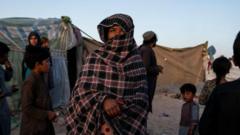Operation Sindoor, named after a traditional Hindu marital symbol, reflects India’s response to a recent terrorist attack. While it signals vengeance for widowed women impacted by violence, critics emphasize the troubling gender dynamics and nationalism it evokes.
The Complex Layers of 'Operation Sindoor': A Symbolic Military Response

The Complex Layers of 'Operation Sindoor': A Symbolic Military Response
India's recent military operation against Pakistan, named "Operation Sindoor," has sparked a poignant discussion around its symbolism and implications.
In a striking move that taps into the cultural psyche of India, the government recently named its military operation against Pakistan "Operation Sindoor." This choice is significantly loaded, evoking the image of a jar of spilled sindoor, a red powder traditionally used to signify the marital status of Hindu women, which in this context also resembles blood.
The operation was propelled into the public consciousness following a tragic terrorist attack on April 22 that left 26 people dead, including Vinay Narwal, the husband of Himanshi Narwal. A poignant image of Ms. Narwal beside her slain husband has made her a symbol of tragedy and a face of the grief experienced by many widowed women. The image went viral, creating a narrative that the government aimed to leverage when justifying its military retaliation.
The name "Operation Sindoor" suggests an effort to channel the collective grief and anger into action, focusing on avenging the loss endured by Hindus. By choosing this particular symbolism, the Indian government aims to resonate not only with the victims’ families but also with a nationalist sentiment that seeks retribution. Punjabi and Hindi right-wing groups have long advocated for stronger military measures against perceived threats, using culturally resonant messaging.
However, the operation isn’t free from controversy. Critics, including feminist historians like V. Geetha, highlight that invoking sindoor in a military context reduces women to mere symbols or figures needing protection within a patriarchal framework. They argue that this approach reflects a male-driven nationalism, where the heroism of men is exalted while women are cast as passive or emotional figures—either suffering losses or encouraging their husbands’ valiant endeavors.
As India navigates its response to terrorism, the implications of how this military operation is framed remain significant. The dual nature of "Operation Sindoor" reflects a blend of cultural homage, nationalistic fervor, and underlying gender narratives that continue to shape discourse in contemporary India.


















